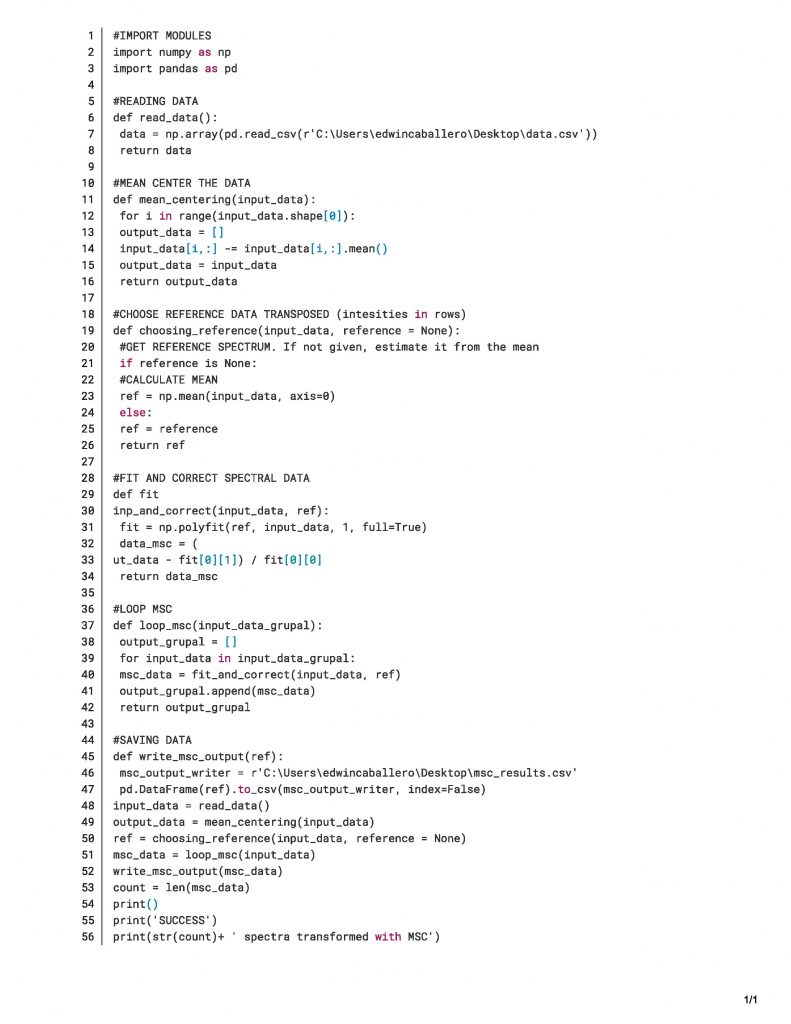This Python script is a set of functions that perform multiplicative scatter correction (MSC) on an input dataset. MSC is a preprocessing technique that corrects for variations in the spectral data due to differences in sample preparation and measurement conditions. The script first imports the numpy and pandas modules, which are used for numerical computing and data manipulation, respectively. The read_data function reads in the data from a .csv file on the user’s desktop using pandas.read_csv. The mean_centering function subtracts the mean of each row from each element in that row. The choosing_reference function either takes a user-specified reference spectrum or calculates the mean spectrum of the input data if no reference is given. The fit_and_correct function fits a line to the input data and reference spectrum, and then uses this line to correct the input data. The loop_msc function applies the MSC correction to a group of input spectra. The write_msc_output function writes the MSC-corrected data to a .csv file on the user’s desktop. Finally, the script applies the MSC correction to the input data, writes the corrected data to a file, and prints the number of spectra transformed with MSC.
How to Run the Code
- Save the script to a file on your computer.
- Make sure that you have the
numpyandpandasmodules installed. If you do not have these modules installed, you can install them usingpip install numpyandpip install pandas. - Open a terminal or command prompt and navigate to the directory where the script is saved.
- Run the script using the command
python scriptname.py, wherescriptname.pyis the name of the script file. - The script will execute and perform MSC on the input data. The corrected data will be written to a
.csvfile on the user’s desktop and the number of spectra transformed with MSC will be printed.
Overall Code
References:
- Harris, C. R.; Millman, K. J.; van der Walt, S. J.; Gommers, R.; Virtanen, P.; Cournapeau, D.; Wieser, E.; Taylor, J.; Berg, S.; Smith, N. J.; Kern, R.; Picus, M.; Hoyer, S.; van Kerkwijk, M. H.; Brett, M.; Haldane, A.; del Río, J. F.; Wiebe, M.; Peterson, P.; Gérard-Marchant, P.; Sheppard, K.; Reddy, T.; Weckesser, W.; Abbasi, H.; Gohlke, C.; Oliphant, T. E. Array Programming with NumPy. Nature 2020, 585 (7825), 357–362. https://doi.org/10.1038/s41586-020-2649-2.
- Reback, J.; McKinney, W.; jbrockmendel; Bossche, J. van den; Augspurger, T.; Cloud, P.; gfyoung; Sinhrks; Klein, A.; Roeschke, M.; Hawkins, S.; Tratner, J.; She, C.; Ayd, W.; Petersen, T.; Garcia, M.; Schendel, J.; Hayden, A.; MomIsBestFriend; Jancauskas, V.; Battiston, P.; Seabold, S.; chris-b1; h-vetinari; Hoyer, S.; Overmeire, W.; alimcmaster1; Dong, K.; Whelan, C.; Mehyar, M. Pandas-Dev/Pandas: Pandas 1.0.3. March 18, 2020. https://doi.org/10.5281/ZENODO.3715232.
- van Rossum, G. Python Reference Manual; Centrum voor Wiskunde en Informatica (CWI), 1995.





